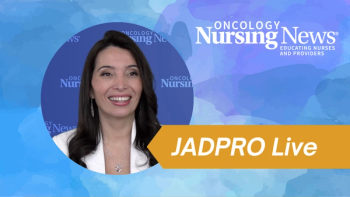
Axi-cel Linked To Longer Quality Time Without Toxicity in Patients With R/R LBCL
A quality time without symptoms of toxicities analysis of the pivotal ZUMA-7 trial found that patients with relapsed or refractory large B-cell lymphoma experienced longer time without toxicity with axicabtagene ciloleucel than with standard of care.
Second-line treatment with axicabtagene ciloleucel (axi-cel; Yescarta) was associated with a significantly longer time without symptoms or toxicities in patients with relapsed or refractory large B-cell lymphoma (R/R LBCL) vs standard of care, according to a quality-adjusted analysis of the ZUMA-7 trial, which was presented during the 2022 ASCO Annual Meeting.
The median duration of time without symptoms or toxicities (TWiST) was 11.18 months (95% CI, 9.73-12.61) with axi-cel and 5.39 months (95% CI, 4.21-6.56) with placebo. The median duration of TWiST of grade 3 or higher was 1.16 months (95% CI, 0.83-1.48) in the experimental arm vs 0.74 months (95% CI, 0.51-0.94). Similarly, the median time after the event was 6.02 (95% CI, 4.9-7.5) vs 10.66 (95% CI, 9.42-11.92). After pooling and adjusting these data, investigators determined the overall quality-adjusted TWiST (Q-TWiST) between the 2 groups was 14.8 months (95% CI, 13.6-15.9) vs 11.1 months (95% CI, 10-12.1).
“Axicabtagene ciloleucel, compared with standard of care, demonstrated a clinically meaningful difference in quality-adjusted survival supporting the use of axi-cel as a second-line therapy for patients with relapsed or refractory large B-cell lymphoma,” the study authors wrote in the poster.
Axi-cel was recently
The estimated 18-month EFS rates in the investigative and control arms were 41.5% (95% CI, 34.2%-48.6%) and 17.0% (95% CI, 11.8%-23.0%), respectively.
Using data from the phase 3 ZUMA-7 trial, which randomly assigned 180 patients to receive axi-cel treatment and 179 patients to receive SOC, investigators used the Q-TWiST method to assess the overall quantity and quality of survival based on the amount of restricted mean time spent in each health state, using the Kaplan Meier curves (95% CI).
A threshold analysis showed that, regardless of the patients’ preference for avoiding adverse events (AEs) and EFS events, axi-cel consistently provided greater quality TWiST and was preferred in either case. Patients who were not bothered by AEs but with a strong preference to avoid EFS events experienced that greatest TWiST gain: 6.2 months (37%). Patients who were not bothered by EFS events but with a strong preference to avoid AEs experienced a smaller but still positive TWiST gain: 1.2 months (6.9%).
With longer duration of follow-up, the Q-TWiST gain became more significant. These findings were significant across subgroups, with the highest gain evident among patients 65 years or older.
Reference
Kersten MJ, Qiao Y, Solem C, et al. Quality adjusted time without symptoms or toxicities (Q-TWisT) analysis of ZUMA-7, a randomized controlled trial of axicabtagene cilocuecel versus standard of care for second-line large B-cell lymphoma. J Clin. Oncol. 2022;40(suppl 16):7555. doi:10.1200/JCO.2022.40.16_suppl.7555 Journal of Clinical Oncology 40, no. 16_suppl


















































































